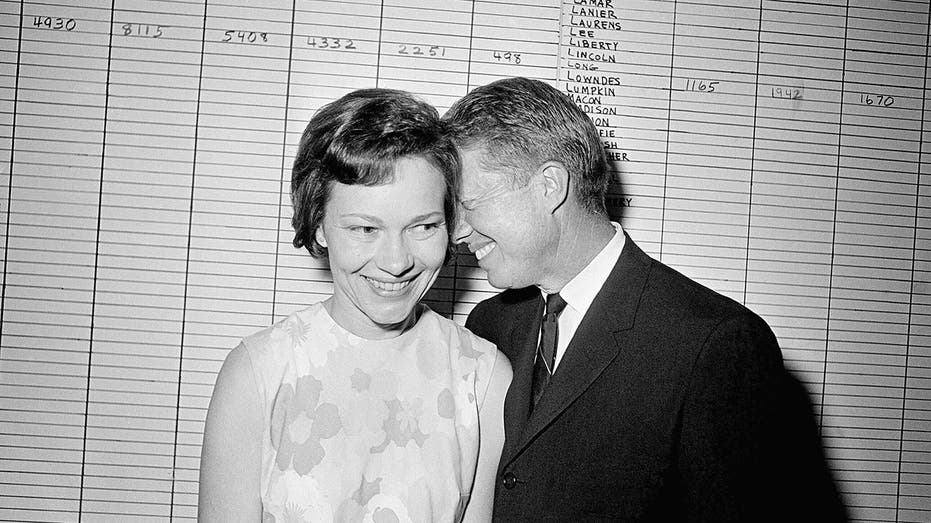Confiscating Russian assets 101: everything you need to know
Confused about why Ukraine can’t just grab Russian frozen assets to fund its fight? We’ve got you covered, from Euroclear to REPO Act.
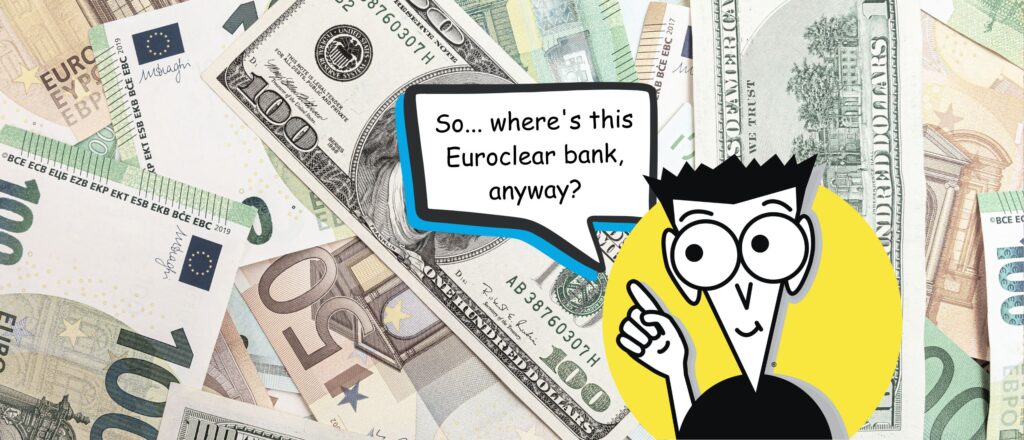

Russia continues to destroy Ukraine, and the West and Ukraine are footing the bill. Meanwhile, the G7 countries have frozen $300 billion of Russian assets in their banks but cannot make the jump to seize them to help Ukraine’s fight.
Why the holdup? Euromaidan Press explains in collaboration with the International Center for Ukrainian Victory.
Is it really possible to make Russia pay for the damage it did to Ukraine?
Not fully. First, we cannot fully calculate the extent of damage; second, human lives are priceless. After Ukraine’s victory, much will remain to be done to bring Russia to justice. But right now, the G7 have frozen Russian assets in their countries, which can be fully used. However, even now, they are already less than the damages suffered by Ukraine, and the size of the damages is still growing.
What are these assets exactly, where are they located, and why are they there in the first place?
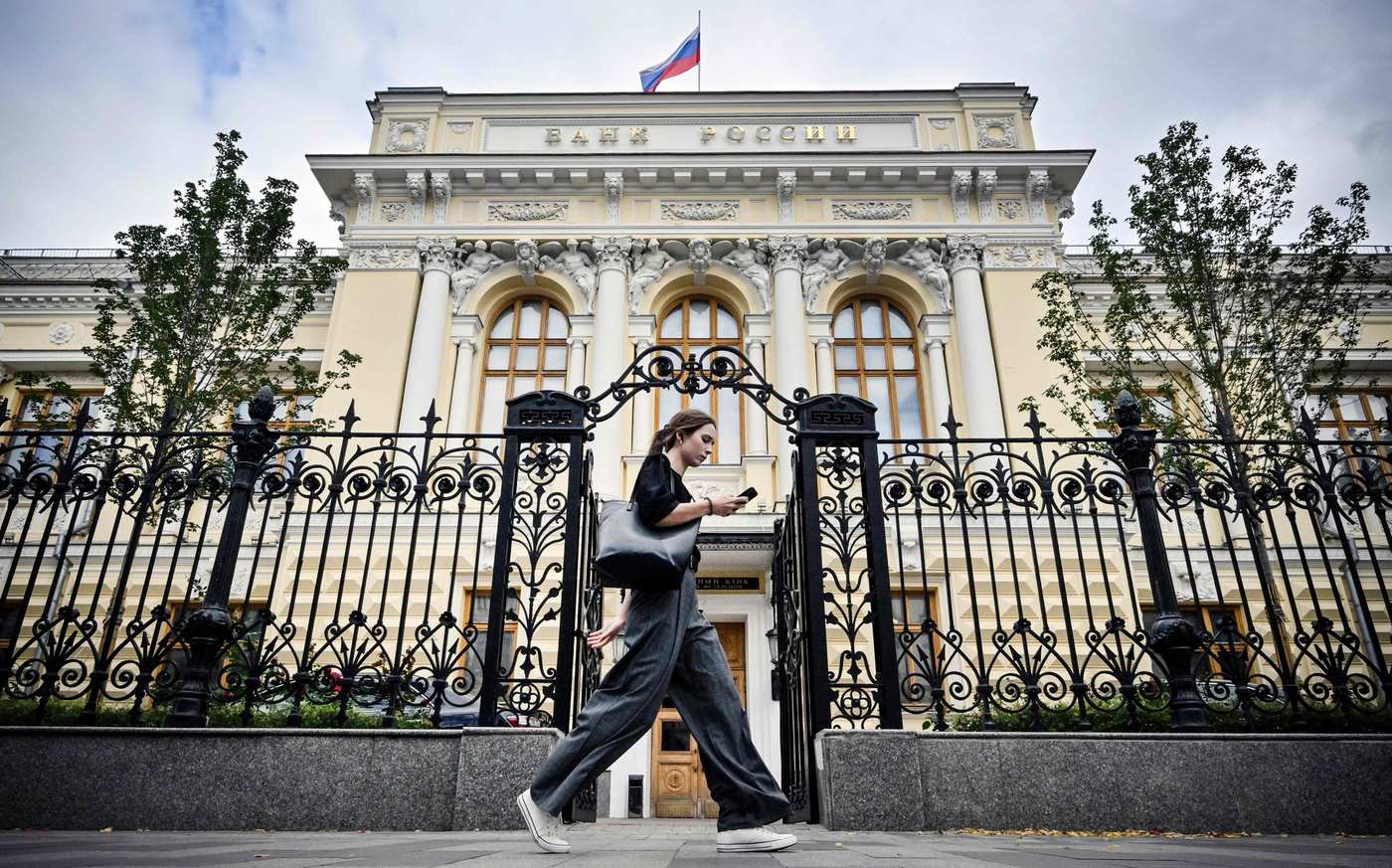
The biggest slice of the pie is Russian state assets (reserves of the Russian Central Bank, Russia’s central financial institution) – $300 billion. They’ve been frozen in banking institutions across the G7 countries.
So why are these assets parked there in the first place?
Well, at the time of Russia’s full-scale invasion of Ukraine, Russia kept some assets in money and securities abroad in reliable banks, scooping up foreign currency.
We know for a fact that the lion’s share of these assets, €192 billion to be precise, is held in Euroclear, a financial institution headquartered in Brussels that specializes in the safekeeping and settlement of securities.

As for the rest of the assets, their exact size and location are a bit of a mystery since that information is classified, but it’s a safe bet that a hefty chunk is in the USA.
There are also Russian private assets floating around abroad, like yachts and businesses belonging to Russian oligarchs and propagandists.
But the total value of these is way smaller than the $300 billion in state assets, and confiscating them is a whole other can of worms. Each country has to make its own call on the matter, and then there’s a court procedure to go through for each individual case, which is going to take a while.
It is also very difficult because the human rights of Russians owning them should be complied with, and the highest legal standards should be applied. That’s why the spotlight is on the state assets, given Ukraine’s urgent military and reconstruction needs. Confiscating these will be a quicker process.
Is it legally possible to just take and confiscate the assets of a state?
This step falls under the category of countermeasures against an aggressor state that has launched an aggressive war and is violating international law left and right. Western countries have already frozen these funds based on this logic, but they haven’t quite mustered up the resolve to fully confiscate them and hand them over to Ukraine.
There have been plenty of times throughout history when states have frozen the assets of other countries as a response to aggression:
- during the crisis when American diplomats were held hostage in the Iranian Revolution back in 1979;
- during Iraq’s invasion of Kuwait in 1990;
- during the brutal crackdown on protests in the Arab Spring in Libya in 2011;
- and during the Venezuelan crisis in 2019.
But actually confiscating those assets and transferring them to the victim country? That’s a lot rarer.
Historically, this has always been part of a post-war settlement, like the Treaty of Versailles after World War I or Germany’s and Japan’s World War II reparations. Directly confiscating frozen assets and handing them over to the victim country while the conflict is still ongoing? That’s uncharted territory.
If the proposed use of frozen Russian assets for Ukraine’s reconstruction actually happens, it would be a pretty big deal in this regard, but there are solid grounds for it.
Russia stands accused of committing genocide in Ukraine and has caused mind-boggling damage to its infrastructure.
The reconstruction bill already stands at a whopping $486 billion, according to the World Bank. The damage to Ukraine’s power grid is especially severe, with Russian strikes destroying 70% of its generating capacity.
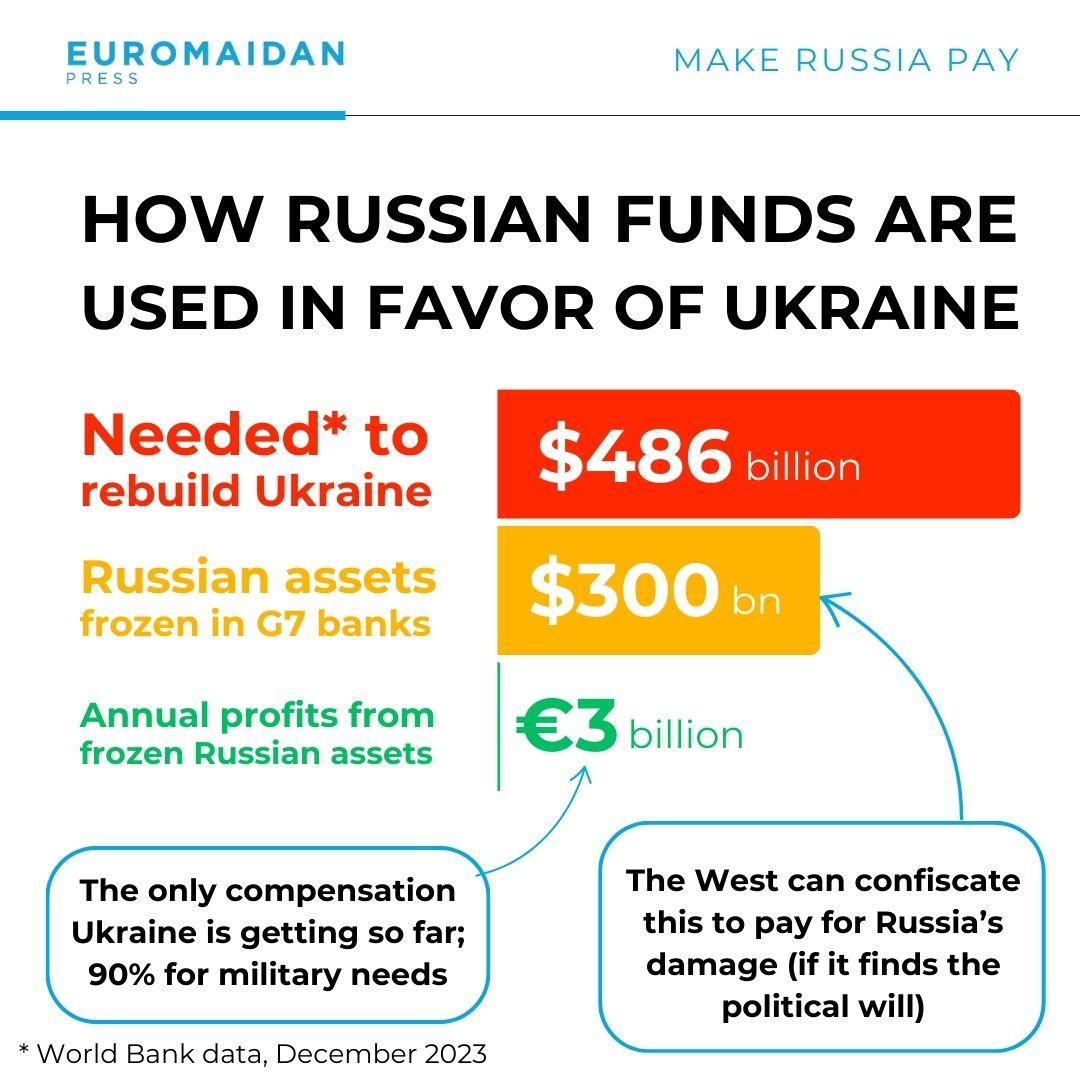
How could these funds actually be confiscated?
Ukraine does not insist that this money is simply given to Ukraine; rather, the plan is to make the funds work for Ukraine’s defense, which is the top priority. There are a few ways this could play out:
- Funneling the money through the European Peace Facility, which pays back EU states for weapons they’ve supplied to Ukraine.
- Having a European Commission body directly buy weapons for Ukraine using the funds.
- Sending the funds straight to Ukraine’s Defense Procurement Agency so they can purchase Ukrainian and foreign-made weapons.
Ukraine is pushing for the ability to buy domestically-produced weapons with these funds, which are less expensive than western-made ones. They’re also beefing up their capacity to handle the funds by ramping up anti-corruption measures.
Beyond defense, the Russian funds are likely to be used for reconstruction and compensation for victims, although the exact breakdown isn’t clear yet.
One big step forward to the confiscation of these funds was the US passing the REPO (Russian Elites, Proxies, and Oligarchs) Act on 23 April 2024.
While successfully implementing it depends on further actions and certifications, the REPO Act lays out a legal mechanism for asset confiscation, gives the President the power to start the confiscation process, and allows for coordination with G7 countries, the EU, and other partners. It could potentially give Ukraine access to an estimated $5-8 billion in Russian sovereign assets located in the US.
However, the G7 did not follow the US’s lead.
Instead, on 3 May 2024, the Financial Times reported that the G7 was no longer considering a full confiscation of frozen Russian assets, with an official saying that these assets could be used as leverage in potential peace negotiations with Russia.
This stance fails to recognize Russia’s true objectives and the pointlessness of using these assets as a bargaining chip, given Russia’s continued escalation of aggression and substantial revenues from fossil fuel exports.

Hi! My name is Alya Shandra, I’m the author of this piece. I believe in the power of data and analysis, and that’s why we try to give you the best of it at Euromaidan Press.
Become our patron to help us bring you the best insights from Ukrainian and foreign analysts so we can cut through the noise together.
Is Ukraine getting anything from these funds currently?
Several initial steps have been taken to ensure that Russia’s frozen funds are already benefiting Ukraine:
- EU foreign ministers have approved using proceeds from frozen Russian Central Bank assets to support Ukraine, which amounts to around €3 billion per year.
- The European Commission has decided to allocate 90% of these proceeds towards military aid for Ukraine.
- At the 14 June 2024 G7 meeting in Italy, it was decided to use proceeds from frozen assets to repay a $50 billion loan for Ukraine, which would also be used 90% for Ukraine’s defense.
This loan would allow Ukraine to survive. However, it would not ensure that Russia is punished for its crimes against mankind, ensure Ukraine’s victory, or compensate Ukraine for the massive damages Russia caused.
Would the confiscation of these assets make a difference for Ukraine?
While Ukraine is set to receive portions of the frozen Russian assets, the entire $300 billion would be a game-changer. To put this sum into perspective:
- It’s twice the amount ($149 billion) the West has spent on military aid to Ukraine since Russia’s invasion in February 2022, according to the Kiel Institute’s Ukraine aid tracker.
- It’s one-third larger than the $211 billion Russia has spent on two years of its war against Ukraine, based on Pentagon estimates.
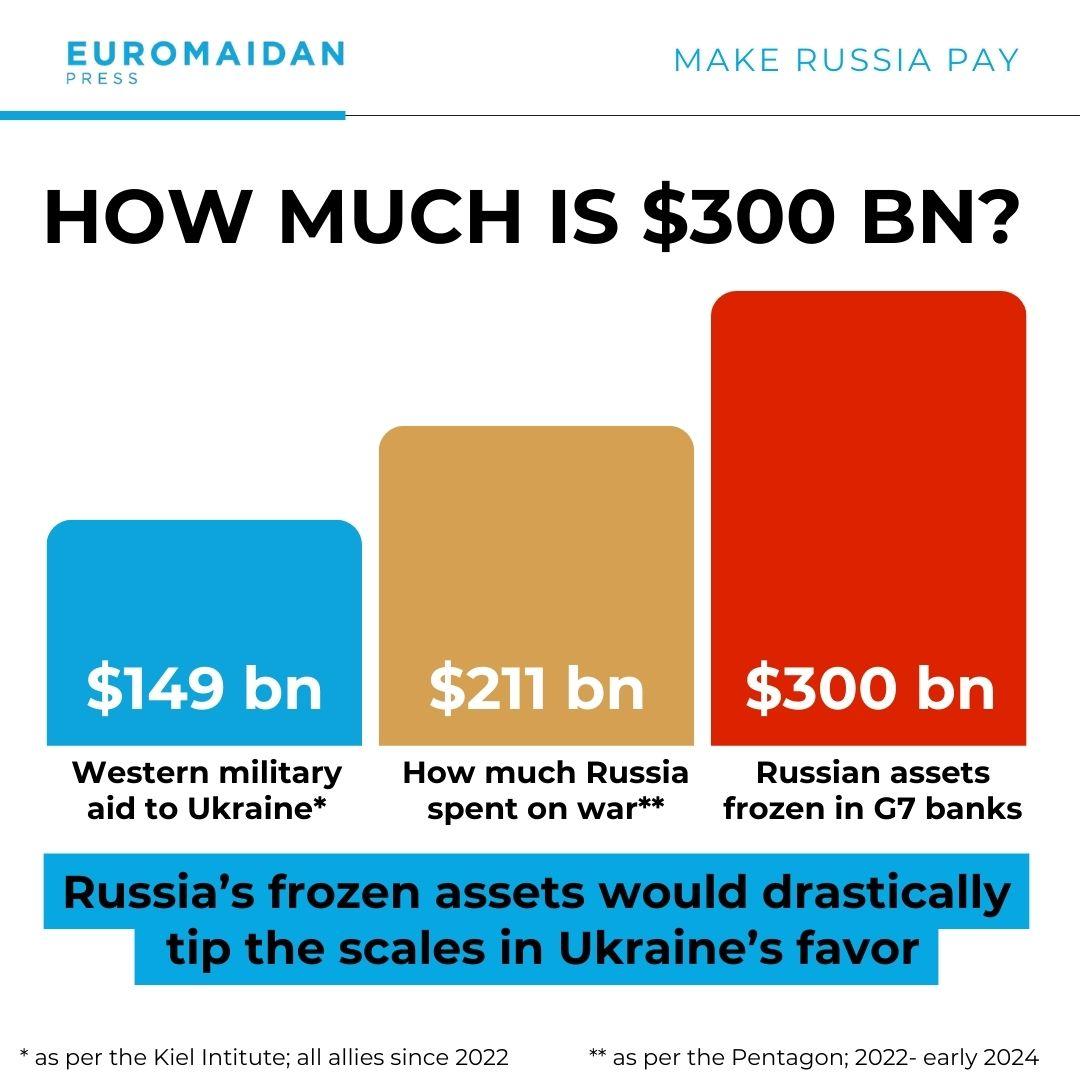
This funding would allow the West to shift from “drip-feeding” weapons to a more impactful “shock and awe” support strategy. It would ensure a stable supply of ammunition and weapons, addressing the kind of shortages that led to Russian gains in spring 2024 when US aid was delayed.
Economist Timothy Ash argues that for Ukraine to pose a serious challenge to Russia, Western aid needs to increase from $100 billion to $150 billion annually. He suggests that using the confiscated assets is:
- More feasible given political uncertainties around future US aid packages
- More equitable, as currently Western taxpayers bear the cost of Russian aggression while Russian assets remain protected
- More strategic in the long run: A Ukrainian defeat would likely result in much higher costs for Europe, including massive refugee flows, increased security risks, and hundreds of billions in additional annual defense spending to counter potential Russian aggression. Providing Ukraine with these funds now could help prevent these costly scenarios.
In essence, this massive injection of funds could provide Ukraine with critical resources while easing the financial burden on Western taxpayers.
How much would those funds help Ukraine on the battlefield?
What could Ukraine do with $300 billion in Russian assets?
To put this sum into perspective, let’s look at the numbers:
- Ukraine started the war with about $38.5 billion worth of military equipment
- Western partners provided an additional $14.9 billion in gear
- Total value of Ukraine’s current military equipment: $54.4 billion
Interestingly, with these resources, Ukraine has managed to destroy Russian equipment worth an estimated $98.7 billion – nearly double the value of their own arsenal (check out how we made these estimates here).
If Ukraine were to receive the full $300 billion, it could potentially increase its military capacity by almost six times. Of course, this is a simplification, as factors like equipment availability also play a role.
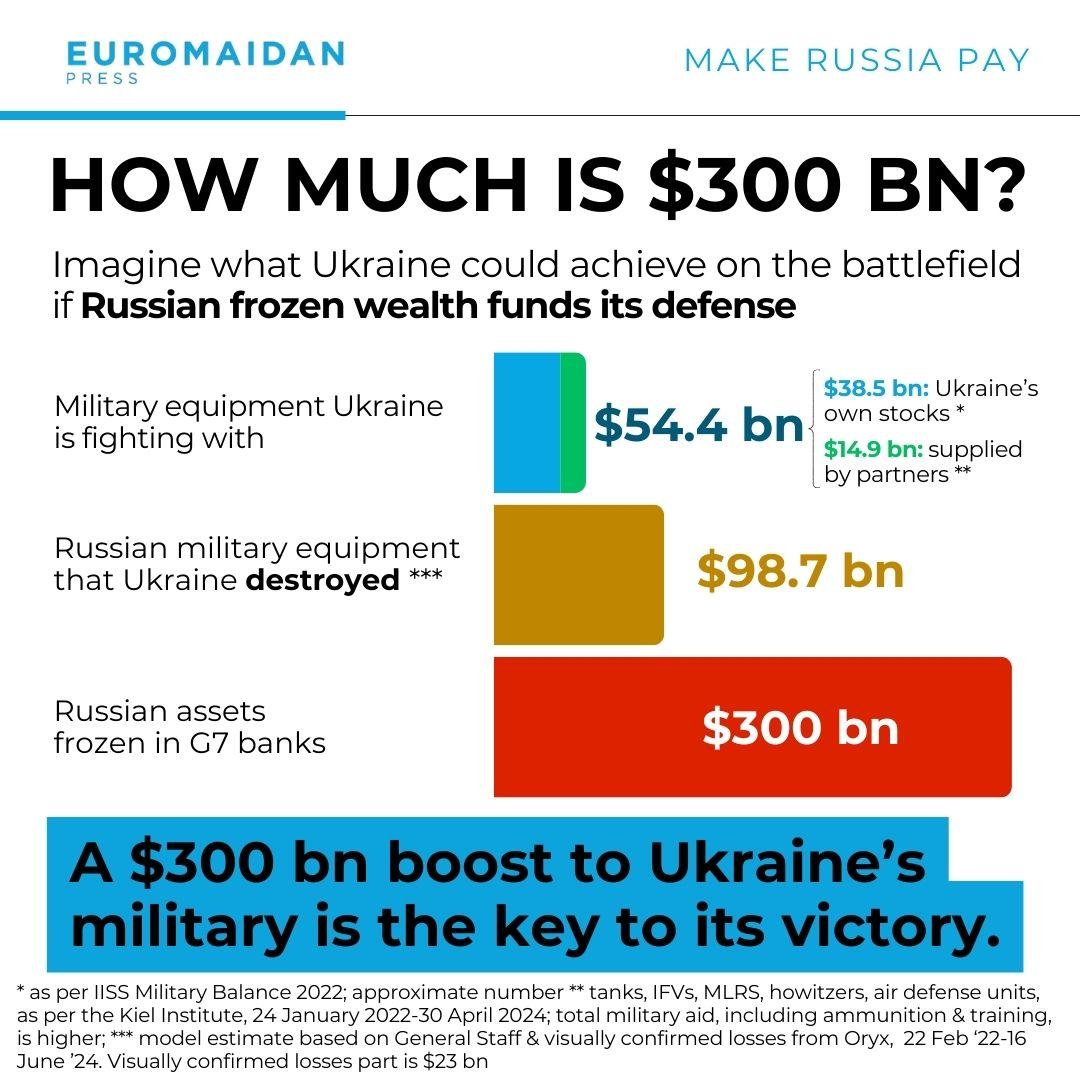
So, what could Ukraine actually buy with this money? According to defense expert Ivan Kyrychevskyi, here’s a potential shopping list:
- Air defense upgrade: 25 Patriot systems with 6-8 batteries each. This would significantly improve Ukraine’s ability to protect its airspace. Additionally, Ukraine could benefit from the THAAD (Terminal High Altitude Area Defense) anti-ballistic missile system. Each THAAD battery costs about $2 billion, but it provides impressive capabilities, intercepting ballistic missiles at ranges up to 200 km and altitudes reaching 100-150 km. This combination of Patriot and THAAD systems would provide Ukraine with a robust, multi-layered air defense network.
- Modern tank fleet: Ukraine needs to increase its tank numbers by 50-100%. Modern tanks like the Leopard-2 now cost around €40 million each, up from €2 million in the 1980s-90s. As well, the American Abrams tank cost has risen from $10 million to $50 million per unit.
- Fighter jets: 120-130 modern jets to match Russia’s air force. A squadron of 10-12 F-16 fighters costs about $1 billion.
- Ammunition: Ukraine requires vast quantities, including 64 billion rounds of small arms ammo ($27 billion) and 17 million artillery shells.
- Long-term contracts: To ensure a steady supply of weapons and support for Ukraine’s defense industry after the war.
Kyrychevskyi estimates this funding could provide Ukraine with a 5-year security cushion. However, he cautions that even with money available, acquiring weapons isn’t always straightforward due to availability issues and rising prices.
If a full confiscation happens, could Russia retaliate by confiscating Western assets?
Russia has already been forcing sales of Western assets at knock-off prices, as well as imposing punitive taxes on Western enterprises for a while now, way before any talk of confiscating Russian assets started:
- March 2022: Russia said “nope” to dividend payments for foreign investors.
- August-October 2022: Putin’s decrees made it hard for companies from “unfriendly states” to move money around.
- December 2022: Russia told foreign shareholders they had to sell their assets at a minimum 50% discount. Ouch.
- April 2023: Russia took “temporary control” of assets belonging to big Western companies, like:
- 98.2% of shares in JSC Fortum (owned by Finland’s state-owned Fortum Oyj)
- 83.73% of shares in Unipro (owned by German state-owned Uniper SE)
- 99.99% of shares in Danone Russia (owned by France’s Produits Laitiers Frais Est Europe) (in 2024 Putin gave Danone’s assets back after Macron had shown his decisive position to support Ukraine and stand up to Russia);
- 98.65% of Baltika LLC (owned by Denmark’s Carlsberg)
- Printing houses owned by Norway’s Amedia.
Reports show that Russia had also basically stolen assets from a bunch of other Western companies by handing them over to state-owned enterprises or Putin’s buddies’ businesses for super cheap:
- Ikea’s stores and factories
- Toyota’s manufacturing plant
- Nissan’s factory
- Renault’s controlling stake in Avtovaz
- Starbucks’ coffee shops
- Krispy Kreme’s operations (now called “Krunchy Dream” – clever, huh?)
Russia did all this in violation of international investment law, so Western companies have every right to hit back. Plus, the longer Western companies stay in Russia, the more likely it is that their assets will get snatched up or sold for peanuts.
So playing nice with Russia on this issue probably won’t do much to protect Western investments anyway.
Could Russia then take the issue of the confiscation of its assets to court and win?
Russia will definitely try to challenge the confiscation of its assets in court, because it can. It will likely file lawsuits in various courts like the EU Court of Justice, the European Court of Human Rights, the International Court of Justice, and international investment arbitration tribunals.
But here’s the thing – Russia’s chances of actually winning these cases are really low.
- In the EU court, Russia might argue that the EU overstepped its authority, but the court will probably side with the EU’s right to make foreign policy decisions.
- The Russian Central Bank will have a hard time even being recognized as a legitimate claimant in the human rights court, and that court allows property seizures for valid public reasons anyway.
- If Russia goes to the International Court of Justice, it would have to accept the court’s jurisdiction and open itself up to legal claims about its own international law violations.
- Investment treaties might give Russia the best shot procedurally, but arbitration tribunals often respect countries’ rights to regulate and have allowed countermeasures against international law violations.
At the end of the day, if asset confiscation measures are well-designed and clearly based on Russia’s well-documented violations of fundamental international laws and norms, they will have a strong legal foundation to withstand Russia’s legal challenges. Careful legal framing can make the measures even more bulletproof.
So while Russia will certainly use whatever legal options it has to fight back, its own blatant disregard for international law leaves it without a strong legal case.
The only courts where Russia is likely to win are Russian ones, and then the decision will apply to the territory of Russia. So, theoretically, Western companies that are still doing business in Russia can be affected, but as we’ve already seen, Putin’s regime can confiscate their assets without any legal pretexts anyway, so it would be wiser for them to simply get out of Russia.
Why wouldn’t other countries pull their money out of Western banks if Russian assets are confiscated?
Some worry that confiscating Russian assets might hurt the EU’s economy. They think the euro could lose value if people start pulling their money out of banks.
There’s a fear that other countries might get spooked, thinking their money isn’t safe in EU banks anymore. This could cause financial trouble in the Eurozone. Big players like China, Saudi Arabia, and Indonesia have been lobbying against asset confiscation, worried about what it might mean for their own money.
But these fears might be blown out of proportion.
Here’s the thing: Russian assets are only on the chopping block because Russia invaded Ukraine. If you’re not planning to invade anyone, you’ve got nothing to worry about. And if you are, perhaps you’ll get second thoughts. Two birds with one stone.
Some are particularly worried about China pulling its investments from Euroclear. But so far, China hasn’t made any threats or official statements about doing this. And they haven’t done anything like this in the past either.
Economist Timothy Ash points out that when the West froze Russian money two years ago, emerging economies did not react in any way.
He also says that even if countries like Saudi Arabia and China wanted to move their money elsewhere, there’s really nowhere else to go. Western banks are still the safest and most reliable places to keep large amounts of money. The euro is still a superstar currency, used in countries with detailed banking laws and high standards to protect people’s money.
Ash adds that if a country did try to move its money, it would probably end up hurting itself more than anyone else. They could face sanctions from Western countries, see less economic growth, have less trade and investment, and even see oil and commodity prices drop. Countries like Saudi Arabia and China care a lot about keeping their economies stable, so they’re unlikely to risk all that just to back up Russia.
So, while some people are worried, it’s pretty unlikely that taking Russian assets would cause other countries to pull their money out of Western banks en masse. The potential downsides for countries trying to move their money, plus the lack of good alternatives to Western banks, make this scenario highly improbable.
So why isn’t the confiscation happening?
At its core, the issue of confiscation comes down to political will.
Despite the various reasons that are raised in discussions about confiscating Russian assets, the true answer is that Western countries still aren’t fully convinced of Ukraine’s eventual victory. As a result, they lack a clear strategy for ensuring Ukraine’s success and Russia’s defeat.
They want to maintain a window for future negotiations with Russia. They fear that asset confiscation will be perceived as a serious escalation and are reluctant to demonstrate strength. They are concerned about jeopardizing future business opportunities, hoping that the familiar world in which Russia was a business partner will eventually return.
The US Congress passing the REPO Act shows that asset confiscation is legally doable and can happen if the political will is there.
Despite this big step forward, the G7 countries still haven’t gathered the courage to do the same.
Recent reports suggest that the G7 is backing off from fully confiscating frozen Russian assets, with some officials hinting that these assets could be used as a bargaining chip in potential peace talks with Russia. This attitude doesn’t recognize the true nature of Russian aggression and the Kremlin’s ultimate goal of replacing the rules-based order with a “might makes right” approach.
Ultimately, the West’s hesitation to confiscate Russian assets comes from not being fully convinced that Ukraine will win in the end and not having a clear plan for making sure Ukraine succeeds and Russia loses.
Some Western countries are still hoping to keep the door open for future negotiations with Russia, worried that taking their assets will be seen as a major escalation. They’re also worried about losing out on future business opportunities, holding onto the hope that the familiar world where Russia was a business buddy will eventually come back.
But Russia’s actions over the past two years have made it clear that it has no plans to return to the rules-based international order.
It’s time for bold moves, and the G7 needs to find the courage to follow the US’s lead in confiscating Russian assets. By doing this, they can show they’re committed to Ukraine’s victory, hold Russia accountable for its crimes, and make it crystal clear that aggression won’t be tolerated in the 21st century.
I like the idea of confiscating Russia’s assets. How can I help?
Everybody’s support matters, and you can help! Raise your voice and tell your politicians, and especially G7 leaders, that the confiscation of Russian assets is a step towards justice, because Russia must pay for the crimes it has done. You could publish appeals to G7 leaders, tagging them, in social media requesting the confiscation of the funds. You could also contact your local politicians and ask them to ask the G7 leaders to give a green light to the confiscation of the funds.
Related:
- How Ukraine could spend $ 300bn in frozen Russian assets to win the war
- No other option: Russian wealth must fund Ukraine’s fight
- Ukraine punches above its weight, destroying $ 98.7 bn of Russian military equipment
- The G7’s frozen asset fiasco: a masterclass in self-sabotage
- Ukraine ramps up anti-corruption safeguards ahead of potential $ 300bn Russian assets transfer

